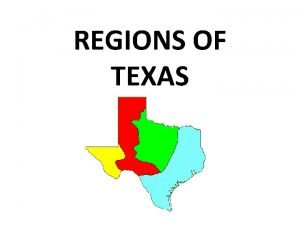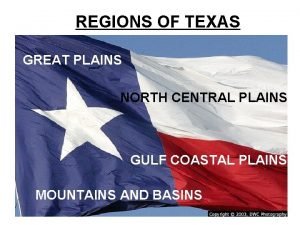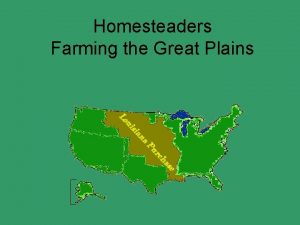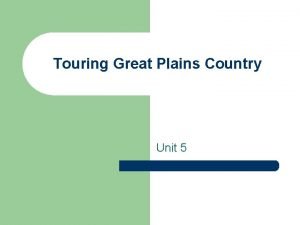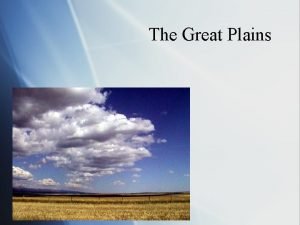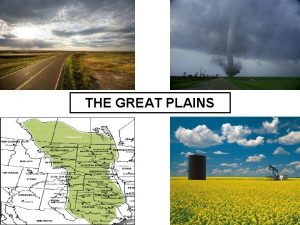SETTLING ON THE GREAT PLAINS Unit 2 Notes










- Slides: 10

SETTLING ON THE GREAT PLAINS Unit 2 Notes – 2 nd day – Pg. 2 & 3

UNIT 2 NOTE QUESTIONS 9/20 & 9/22 1. Which social issue is addressed in the cartoon? A. B. C. D. Industrial Safety Training of teachers Obligatory Public Education Organization of Immigrant laborers 2. Based on the cartoon, which conclusion can be made about the U. S. in the 1900 s? A. The government assumed an active role in suppressing social activists B. The government assumed an active role in legislation social reform. C. Business monopolies controlled the means of production. D. Business owners monitored the activities of laborers.

RAILROADS OPEN THE WEST Buffalo herds were decreasing causing Native Americans to be forced on smaller reservations. As cattle ranches open, ranching became a profitable investment. American settlers learned to manage large herds from Mexican vaqueros. Growing demand for beef in rapidly growing cities post. Civil War. Cattlemen establish shipping yards where trail and rail lines meet. Chisholm Trail becomes major cattle route from San Antonio to Kansas.

SETTLERS MOVE WESTWARD TO FARM 1866 – 1885, up to 55, 000 cowboys on plains 25% African American, 12% Mexican Cowboys work 10 – 14 hours on ranch, 14 or more on trail Long Drive, herding of animals, lasts about 3 months; cowboys sleep on the ground & bathe in rivers Overgrazing and bad weather from 1883 – 1887 destroy whole herds. Ranchers keep smaller herds that yield more meat per animal Settlers on the Great Plains begin to transform the land despite great hardships. Ranchers use barbed wire as fences and turn plains into separate ranches.

GOVERNMENT SUPPORTS WESTWARD SETTLEMENT 1850– 1871, huge land grants to railroads for laying track in West By 1880 s, 5 transcontinental railroads completed Railroads sell land to farmers, attract many European immigrants In 1862 the government passed the Homestead Act; offered 160 acres FREE to any head of household in agreement that they build a home, make improvements, farm the land for five years before being granted full ownership. 1862 – 1900 up to 600, 000 families settle Railroad, state agents, speculators profit 10% of land to families

CLOSING OF THE FRONTIER 1872 Yellowstone National Park created to protect some wilderness In 1890 the Census Bureau declared that the country no longer had a continuous frontier line; the frontier no longer existed. Few trees left; many settlers dig homes into sides of hills Make Soddy homes by stacking blocks of turf

WOMEN ON THE FRONTIER Homesteaders (women) virtually alone, must be self-sufficient Do “men’s work” – plowing, harvesting, shearing sheep & traditional work (cooking, cleaning, etc. ) Women work for communities – sponsor schools & churches

Sorry – video is too large to upload Unit 2 Note Questions 9/20 & 9/22 3. Women, like everyone else, came to the West for an ________. 4. Entire towns sprung up around ________. 5. What was the first territory to give women the right to vote?

AGRICULTURAL EDUCATION Mass market for farm machines developed with migration to plains. Morrill Act of 1862 & 1890 gave federal land to the states to help finance agricultural colleges; many states sold most of the land used the proceeds to fund education; significant because it was the first time the federal government provided assistance for higher education.

FARMERS IN DEBT Railroads and investors create bonanza farms – huge single-crop spreads of 15, 000 to 50, 000 acres. Large operations couldn’t compete with smaller farms, which could be more flexible in the crops they grew. Bonanza farms slowly folded into bankruptcy. Farmers also felt pressure from the rising cost of shipping grain; railroads charged western farmers a higher fee than they did farmers in the East; railroads claimed they were merely doing business, but farmers resented being taken advantage of.
 Settling on the great plains section 2
Settling on the great plains section 2 Central plains location
Central plains location Settling the west part 2 packet- farming the plains
Settling the west part 2 packet- farming the plains What are the central plains
What are the central plains Midland and odessa are located in the mountains and basins.
Midland and odessa are located in the mountains and basins. North america east region
North america east region Microsoft business solutions great plains
Microsoft business solutions great plains Great plains ada center
Great plains ada center Landforms in the high plains
Landforms in the high plains Great plains
Great plains Great plains veterinary educational center
Great plains veterinary educational center



